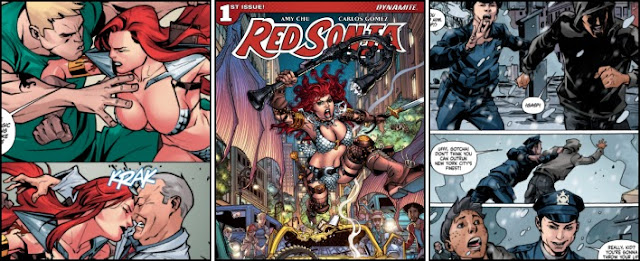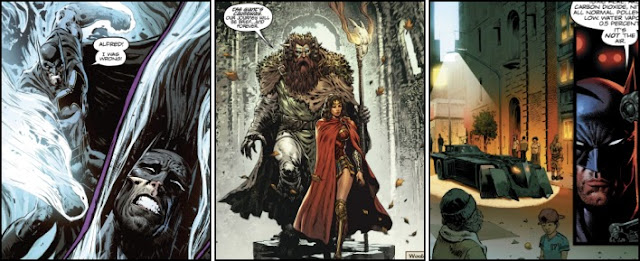 |
| RED SONJA No. 3, March 2017 |
Incredibly however, even these coincidences fail to compare to the Boston-born writer’s misguided belief that a warrior woman from a mythical land can simply hop onto a modern-day motorbike, pull off a pretty impressive-looking Evel Knievel wheelie and then speed off onto the New York City freeway just because Robert E. Howard’s creation has watched Sir Max of Bushwick ride the machine once before. Admittedly, Sonja’s freshly found skill does provide this comic with a momentous opportunity to have the sword-wielding six-footer, complete with a biker’s black leather jacket, momentarily mow down her assailants and subsequently careen through the Big Apple’s intolerant traffic. But for many this Borg-like assimilation of a modern-day transportation mode is debatably taking a person’s willing suspension of disbelief a step too far…
Fortunately though, all these fortuitous affairs are sketched by Carlos Gomez, so even if their lack of gritty realism grates upon the nerves, each providential progression is at least illustrated with plenty of life-imbuing vigour. Indeed, this publication’s conclusion, which depicts Sonja and her friends crashing the Columbia Centre for Hyborian Studies Annual Dinner, provides an otherwise lack-lustre narrative with some much needed excitement as the professional penciller draws the leading lady disarming gun-toting agents with her thigh-knife and denting their heads with the hilt of her formidably-sized blade; “See. Sir Max? I kill no one.” Plus, the Spaniard also even manages to please the pulp fiction devotees with a fleeting glimpse of the Kingdom of Meru’s Grand Bazaar “before it was destroyed by the evil sorcerer Kulan Gath.”
 |
| The regular cover art of "RED SONJA" No. 3 by Mike McKone |


































